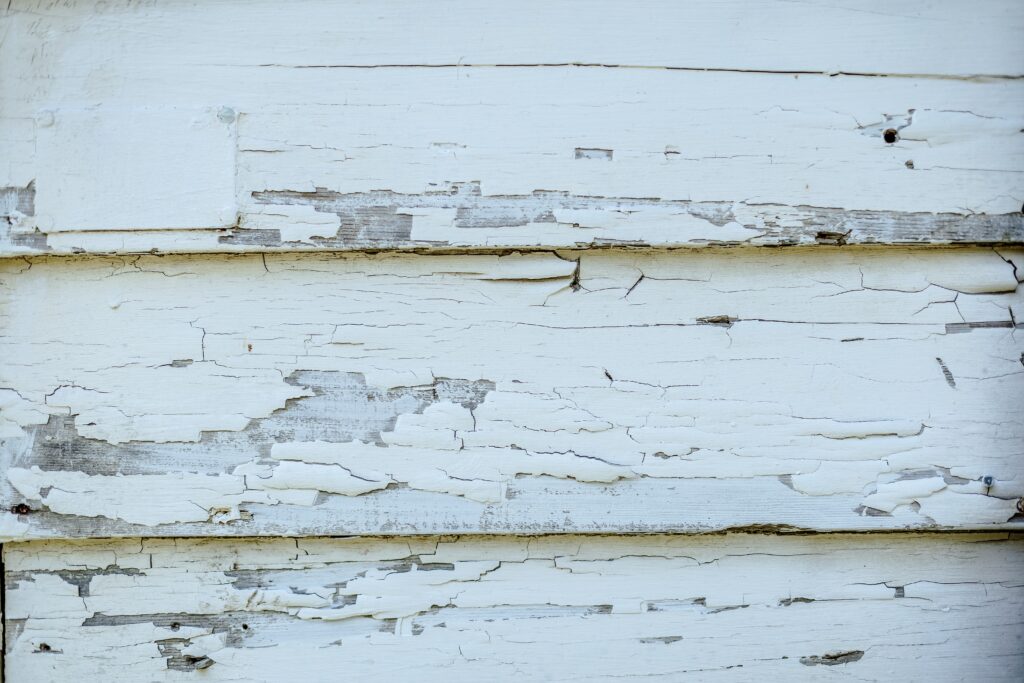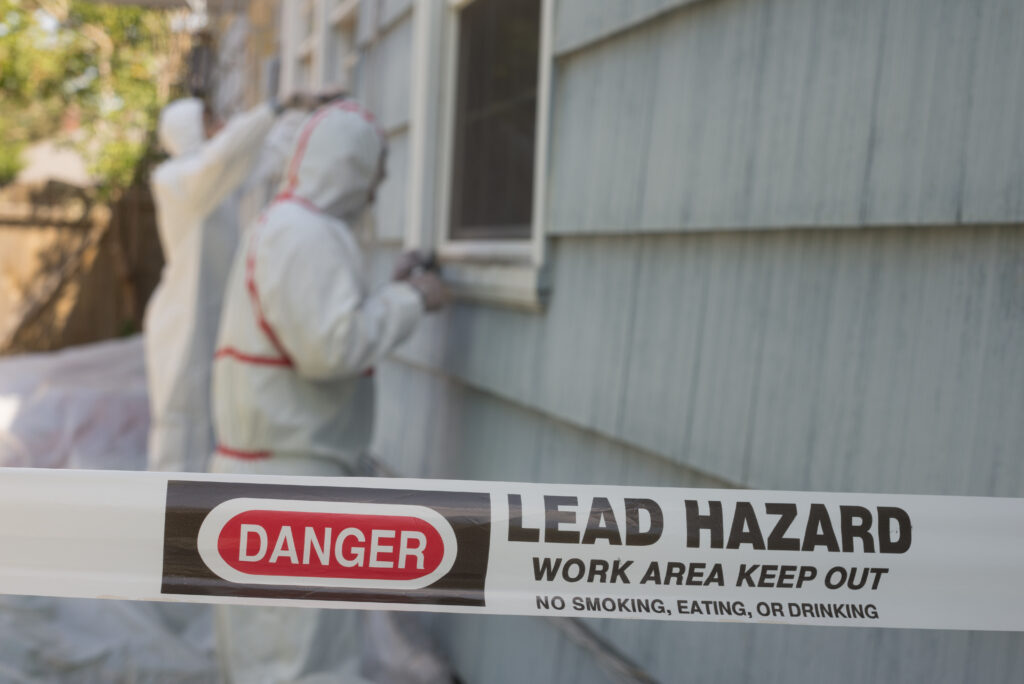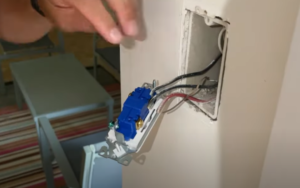If you own an older home, you may be wondering how to determine if your home has lead paint? The most straightforward method is using a home lead paint test kit, available at most hardware stores or directly from Amazon. See our detailed review of the Best Lead Home Lead Paint Test Kts. These kits provide immediate results, allowing homeowners to take the necessary steps toward a safer living environment. For a more comprehensive assessment, hiring a professional inspector who specializes in lead detection can offer peace of mind and accuracy.
Understanding Lead Paint and Its Dangers
Lead paint, once a common household paint ingredient, has been banned in residential use since 1978 due to its toxic nature. Exposure to lead paint dust or chips can lead to serious health issues, particularly in children and pregnant women, including cognitive impairments and developmental delays. Recognizing this as one of the the potential dangers in your home is the first step in safeguarding your family.
Identifying Lead Paint in Your Home
If your home was built before 1978, there’s a chance it contains lead paint. Signs include peeling, chipping, or cracking paint. However, visual inspection alone can’t confirm the presence of lead. This is where a home lead paint test kit becomes invaluable. Simple to use, these kits can detect lead on painted surfaces, helping you identify areas of concern.

How Home Lead Paint Test Kits Work
Home lead paint test kits are designed for easy use, allowing homeowners to conduct safe, preliminary assessments of painted surfaces for lead content. These kits typically include swabs or strips that are applied to the wall or paint surface in question. Here’s a step-by-step overview of how these kits generally work:
- Preparation: Before testing, ensure the area is clean and dust-free. If you need to expose an underlying layer of paint (in cases where multiple layers of paint are present), carefully cut a small notch through the layers without creating dust.
- Application: Follow the kit’s instructions to activate the testing swab or strip. This usually involves squeezing or bending the swab to release a detecting agent.
- Testing: Press the activated swab or strip against the paint surface for the recommended amount of time, typically a few seconds to a minute.
- Observation: After the recommended contact time, observe the color change of the swab or strip. Most kits use a color change (e.g., pink or red) to indicate the presence of lead. The specific colors and interpretation of results will depend on the brand and type of test kit used.
- Confirmation: It’s important to note that while these test kits can provide a quick indication of lead presence, they may not detect very low levels of lead paint. For a more comprehensive assessment, or if the test kit indicates the presence of lead, consulting a professional lead inspector for a thorough evaluation is advisable.
Paint Live TV does a nice job at showing how easy it is to use one of these kits.
The Role of Home Inspectors in Lead Paint Detection
Many homeowners wonder, “Do home inspectors check for lead paint?” This is especially important if you are in market to buy a home, or if you have recently bought an older home. Generally, standard home inspections do not include lead paint testing. However, some inspectors are qualified to conduct such tests, or they may recommend a specialist. It’s essential to clarify this before hiring an inspector, especially if you suspect your home might have lead paint.

Health Risks and Symptoms of Lead Exposure
Lead is a toxic metal that can cause significant health problems if ingested or inhaled, particularly in children under six years old, pregnant women, and other vulnerable populations. The health risks associated with lead exposure are severe and can have lasting effects.
For Children
Children are especially susceptible to the harmful effects of lead. Exposure can lead to:
- Developmental Delays: Lead can interfere with the development of the nervous system, resulting in cognitive impairments and reduced IQ.
- Behavioral Issues: Lead exposure has been linked to increased aggression, hyperactivity, and attention problems.
- Learning Difficulties: Children exposed to lead may struggle with academic performance due to difficulties with concentration and memory.
- Hearing Problems: High levels of lead exposure can affect a child’s hearing, leading to auditory processing issues.
For Pregnant Women
Lead exposure during pregnancy can affect both the mother and the unborn child, including:
- Premature Birth: Lead can increase the risk of premature delivery.
- Low Birth Weight: Babies exposed to lead in utero may have a lower birth weight, which can affect their health and development.
- Developmental Issues: There’s a risk of developmental delays and learning difficulties in children exposed to lead before birth.
For Adults
Adults can also suffer from lead exposure, with symptoms and health effects including:
- High Blood Pressure: Chronic lead exposure has been linked to an increased risk of hypertension.
- Kidney Damage: Over time, lead accumulation can cause damage to the kidneys, affecting their ability to filter waste from the blood.
- Reproductive Problems: Both men and women can experience reproductive issues due to lead exposure, including reduced sperm count and abnormal menstrual cycles.
- Cognitive Decline: Adults exposed to high levels of lead may experience memory loss, decreased concentration, and reduced cognitive function.
Common Symptoms of Lead Poisoning
The symptoms of lead poisoning can vary depending on the level and duration of exposure. Common symptoms include:
- Abdominal pain and cramping
- Fatigue and weakness
- Headaches
- Irritability and mood disorders
- Loss of appetite and weight loss
- Numbness or tingling in the extremities
- Memory loss and difficulty concentrating
Because these symptoms can be mistaken for other conditions, it’s crucial to consider potential lead exposure, especially in homes with lead paint or in individuals with occupations that involve lead. If lead poisoning is suspected, a blood test can confirm exposure levels and guide appropriate treatment and intervention strategies.
Understanding the health risks and symptoms of lead exposure underscores the importance of preventing lead exposure, particularly in homes with young children or pregnant women. Testing for lead paint using [home lead paint test kits] and seeking professional evaluation and remediation can significantly reduce the risk of lead poisoning and its associated health effects.
Professional Lead Paint Removal and Safety Measures
If a home lead paint test kit indicates the presence of lead in your home, the next step is to consider professional lead paint removal. Lead paint removal is a complex process that requires specialized knowledge, tools, and safety precautions to prevent lead dust from contaminating the air and surrounding surfaces.

Why Choose Professional Lead Paint Removal
Professional lead paint removal services are equipped to safely remove or stabilize lead-based paint, using techniques such as:
- Wet Scraping: Applying a mist of water before scraping to minimize dust.
- Chemical Stripping: Using chemicals to strip lead paint without generating dust.
- Encapsulation: Applying a specialized coating that seals lead paint in place, preventing it from chipping or creating dust.
These methods ensure that lead paint is removed or contained without posing a risk to the home’s occupants or the environment.
Finding a Professional Lead Paint Removal Service
Finding a reputable and qualified lead paint removal service is essential for ensuring the safety and effectiveness of the removal process. Here are steps to guide you in finding the right professional service:
- Certification: Look for services that are certified in lead paint removal. In the United States, the Environmental Protection Agency (EPA) certifies contractors for lead paint removal. Check for EPA Lead-Safe certified firms in your area.
- Experience: Choose a service with extensive experience in lead paint removal, particularly in homes similar to yours. Experienced contractors will be familiar with the best practices and safety measures necessary to handle lead paint effectively.
- References and Reviews: Ask for references from past clients and check online reviews to gauge the quality of the service and customer satisfaction. This can provide insight into the reliability and professionalism of the contractor.
- Quotes and Assessments: Contact multiple services for quotes and, if possible, request an on-site assessment. This will not only give you an idea of the cost but also allow the contractor to evaluate the extent of the lead paint problem.
- Safety Protocols: Inquire about the safety measures the service will use to protect your family and property during the removal process. A reputable service should follow strict safety guidelines, including sealing off work areas and using HEPA filters to prevent lead dust from spreading.
- Disposal: Ensure that the service is knowledgeable about proper disposal methods for lead-contaminated materials. Lead paint and dust must be disposed of according to local and federal regulations to prevent environmental contamination.
- Insurance and Licensing: Verify that the contractor is fully insured and licensed to perform lead paint removal in your state. This protects you in case of accidents or damage to your property during the removal process.
Preventing Lead Exposure in Your Home
Living with lead paint in your home can be safe, provided the paint is in good condition and proper precautions are taken to prevent exposure. Lead paint that is intact, undisturbed, and not chipping or peeling generally does not pose a direct hazard. However, it’s essential to remain vigilant and employ preventative measures to ensure the ongoing safety of your living environment.
Regular Inspection and Maintenance
- Regularly inspect painted areas for signs of wear and tear, such as chipping, peeling, or cracking. Early detection allows for prompt action before lead dust becomes a hazard.
- Maintain painted surfaces in good condition, particularly around windows, doors, and other areas subject to friction and movement, to prevent the generation of lead dust.
Minimizing Lead Dust
- Practice safe cleaning methods to minimize lead dust. Use a damp cloth for dusting and a wet mop on floors, preferably with a cleaning solution that reduces lead dust adherence.
- HEPA vacuum cleaners can effectively capture lead particles and should be used for regular cleaning, especially in older homes.
Safe Renovation Practices
- Hire lead-safe certified contractors for any renovation, repair, or painting projects that might disturb painted surfaces in homes built before 1978. These professionals are trained to minimize, contain, and clean up lead dust.
- Avoid DIY methods that generate lead dust, such as sanding or using a heat gun at high temperatures. If you must do work yourself, use lead-safe work practices and wear appropriate personal protective equipment.
Soil Safety
- Test your yard’s soil for lead, especially if you live in an older home or near a busy road. Lead from exterior paint or past emissions can contaminate soil.
- Practice safe gardening by using raised beds with clean soil for growing vegetables and ensuring children play in areas with uncontaminated soil.
Living Safely with Lead Paint
It is possible to live safely in a home with lead paint by taking proactive steps to prevent exposure. Ensuring that lead paint is properly managed and contained, combined with regular cleaning and maintenance, can significantly reduce the risk of lead poisoning. However, if lead paint is deteriorating, or if renovation projects are planned, professional assessment and removal may be necessary to ensure safety.
Living in a home with lead paint requires ongoing vigilance and adherence to safety measures to protect your family’s health. By implementing these preventative strategies, you can create a safe and healthy living environment, even in older homes with lead paint.
Legal and Financial Assistance for Lead Paint Issues
Navigating the legal and financial aspects of lead paint removal can be challenging for homeowners. However, understanding your rights and the resources available can significantly ease the burden of ensuring your home is safe from lead hazards.
Legal Requirements for Disclosure
When selling or renting a property built before 1978, federal law requires owners to disclose any known lead-based paint and lead-based paint hazards. Buyers must be given a 10-day period to conduct a lead-based paint inspection or risk assessment at their own expense. This requirement underscores the importance of being informed about the lead status of your property and ensuring compliance with regulations to avoid legal repercussions.
Financial Assistance Programs
For homeowners concerned about the cost of lead paint removal, there are several financial assistance programs available to help. One notable program is offered by the U.S. Department of Housing and Urban Development (HUD).
HUD’s Lead-Based Paint Hazard Reduction Program
HUD provides grants to state and local governments through its Lead-Based Paint Hazard Reduction Program to assist in identifying and controlling lead-based paint hazards in eligible privately-owned rental or owner-occupied housing. This program aims to promote safe, lead-free homes by providing funds for lead hazard control work, risk assessments, and inspections.
For more information about the program and to see if you qualify for assistance, visit HUD’s Lead Hazard Control and Healthy Homes website.
Applying for Assistance
To apply for financial assistance through HUD or other programs, homeowners should:
- Check Eligibility: Review the specific eligibility requirements for the program, which may include income limits, property location, and the presence of children under six years old living in or frequently visiting the home.
- Gather Documentation: Prepare necessary documentation, such as proof of ownership, income verification, and evidence of lead hazards.
- Submit Application: Complete the application process as directed by the program. This may involve submitting forms online, by mail, or through a local agency.
Additional Resources
Many states and local governments offer their own lead hazard control programs with financial assistance for lead paint testing and removal. Contacting your local health department or housing authority can provide information on available resources in your area.
Ensuring Your Home is Safe from Lead Paint
Testing for lead paint is a critical step for homeowners, especially those in older properties. Using a [home lead paint test kit] offers a practical first step in identifying potential hazards. For comprehensive evaluation and removal, professional services are recommended. Staying informed and proactive can protect your family from the dangers of lead exposure, making your home a safer place for everyone.
Remember, while home lead paint test kits are useful for initial screening, they are just the beginning of ensuring your home is safe from lead hazards. Regular inspections and maintenance, combined with professional advice and services, are key to managing and mitigating the risks associated with lead paint.




